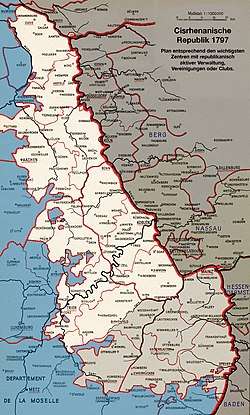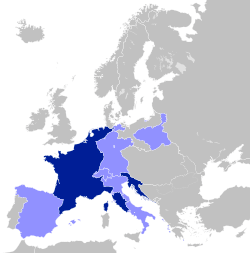Cisrhenian Republic
| Cisrhenian Republic Cisrhenanische Republik | |||||||||||||||||||||
|---|---|---|---|---|---|---|---|---|---|---|---|---|---|---|---|---|---|---|---|---|---|
| 1797–1802 | |||||||||||||||||||||
 Flag | |||||||||||||||||||||
 Cisrhenian Republic in 1797 | |||||||||||||||||||||
| Status | Client state of France | ||||||||||||||||||||
| Capital | Cologne | ||||||||||||||||||||
| Government | Republic | ||||||||||||||||||||
| Historical era | Napoleonic Wars | ||||||||||||||||||||
• Creation | 28 August 1797 | ||||||||||||||||||||
• De jure annexed by France | 28 August 1802 | ||||||||||||||||||||
| |||||||||||||||||||||
The Cisrhenian Republic (German: Cisrhenanische Republik) was a client state (sister republic) of the French Revolutionary Wars. It was proclaimed in 1797 on the Left Bank of the Rhine under French occupation.
History
At the beginning of the War of the First Coalition, in 1792, French revolutionary troops conquered the Palatinate region and occupied the cities of Mainz, Speyer, and Worms. They terminated the centuries-long reign of the local nobility and clergy, which met with approval among broad sections of the public. A German Jacobin Club was established at Mainz in October to promote the export of revolution in the lands of the Holy Roman Empire together with the occupying forces. The short-lived Republic of Mainz, established in March 1793, was the first attempt to implement a democratic state on current German territory. The Republic ended after Prussian and Austrian coalition troops started the Siege of Mainz and forced the surrender of the city.

After the levée en masse from August 1793, French forces were able to conquer vast territories on the Left Bank of the Rhine up to the 'natural Rhine border' proclaimed by Georges Danton in the National Convention. Under the terms of the 1795 Peace of Basel, the Kingdom of Prussia had been compelled to cede all her territories west of the Rhine river, but the French forces initially failed to coordinate a civil administration or to establish a Rhenish buffer state, and the ongoing occupation at the expense of the civilian population met with growing rejection. The situation did not improve until, in early 1797, the French Directory delegated General Louis Lazare Hoche to build up an orderly public administration based on the French model.
On 13 April 1797, at the suggestion of General Hoche, the Directory resolved upon the establishment of a républic separée on the west-Rhenish territories of the Electorates of Trier, Mainz and Cologne, of the Electoral Palatinate, the duchies of Arenberg and Jülich-Berg, the free cities of Aachen and Cologne, and several smaller counties and lordships. Together the Rhenish lands from Cleves up to Bingen were combined into the short-lived Cisrhenian Republic under the rule of General Hoche as 'Protector'. The republican movement was again gaining a substantial following, at least in Rhenish cities such as Bonn or Koblenz.

In view of Napoleon's Italian campaign and the creation of the Cisalpine Republic in June 1797, German democrats like Joseph Görres urged the proclamation of the Cisrhenian Republic, which took place on 28 August with the first hoisting of a green, white and red tricolour flag in Cologne. Similar ceremonies were also held in Rheinbach, Koblenz and Bonn, accompanied by the planting of "liberty trees" throughout the country. The number of supporters of the Republic among the population is difficult to assess from today's perspective. In any case, the strong presence of occupying troops, entailing taxes and contributions, persisted.
Meanwhile, the Coup of 18 Fructidor (4 September 1797) in Paris boosted radical forces demanding an annexation of the Left Bank by the French motherland. When General Hoche died unexpectedly on September 18 at the age of 29, the Cisrhenian Republic lost her strongest advocate. By the Treaty of Campo Formio on 18 October 1797, Emperor Francis II accepted the Rhine border and the administration of the region was officially assigned to France. By 1798 the lands west of the Rhine were organized by French Commissioner François Joseph Rudler into the départements of Roer, Rhin-et-Moselle, Sarre and Mont-Tonnerre. Rudler also had the French Code civil implemented, what de facto marked the end of the planned autonomous Republic.
The French annexation was internationally accepted in the 1801 Treaty of Lunéville. Nevertheless, the Rhineland was not officially incorporated until 23 September 1802. The inclusion of the western bank of the Rhine into the French Empire also led to the Reichsdeputationshauptschluss.
